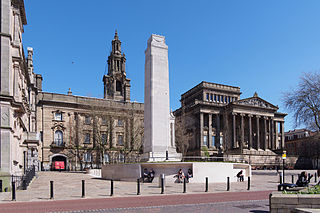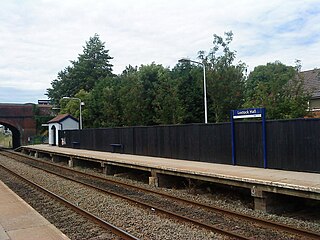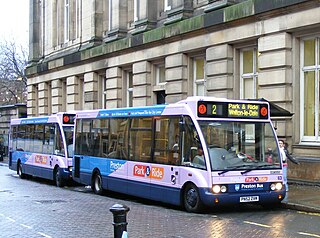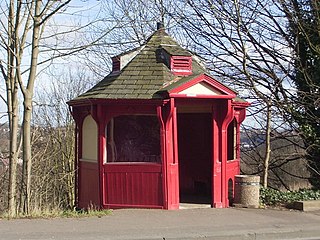
Preston is a city on the north bank of the River Ribble in Lancashire, England. The city is the administrative centre of the county of Lancashire and the wider City of Preston local government district. Preston and its surrounding district obtained city status in 2002, becoming England's 50th city in the 50th year of Queen Elizabeth II's reign. Preston has a population of 114,300, the City of Preston district 132,000 and the Preston Built-up Area 313,322. The Preston Travel To Work Area, in 2011, had a population of 420,661, compared with 354,000 in the previous census.

The Lancaster Canal is a canal in North West England, originally planned to run from Westhoughton in Lancashire to Kendal in south Cumbria. The section around the crossing of the River Ribble was never completed, and much of the southern end leased to the Leeds and Liverpool Canal, of which it is now generally considered part.

Melbourne tram route 112 was operated by Yarra Trams on the Melbourne tram network from West Preston to St Kilda. The 18 kilometre route was operated out of East Preston depot with A, B and D2 class trams.

Avenham Park is a public park in Avenham, close to the centre of Preston in Lancashire in the northwest of England, and managed by Preston City Council.
The Preston and Wyre Railway was promoted to open up agricultural land in the Fylde in Lancashire, access a new port at what became Fleetwood and the Lancaster Canal at Preston: it opened in 1840. An associated company built the dock leading to the company changing its name to the Preston and Wyre Railway, Harbour and Dock Company. Passenger business was more buoyant than expected, and the company built branch lines to the nascent resort of Blackpool and Lytham that opened in 1846. At that time the line was leased by the Lancashire and Yorkshire Railway and later the London and North Western Railway took a share in the lease which was later converted to outright ownership. The Preston and Wyre Railway continued to be jointly owned as the Preston and Wyre Joint Railway.

Blackpool North railway station is the main station serving the seaside resort of Blackpool in Lancashire, England. It is the terminus of the main Blackpool branch line and is 17+1⁄2 miles (28 km) northwest of Preston.

Lostock Hall railway station is a railway station serving the village of Lostock Hall in the South Ribble borough of Lancashire, England. It is on the East Lancashire Line and is managed by Northern, who also provide all passenger trains serving it.
Dick, Kerr and Company was a locomotive and tramcar manufacturer based in Kilmarnock, Scotland and Preston, England.

Ribbleton railway station was on the Preston and Longridge Railway in Ribbleton, a suburb of Preston, Lancashire, England.

The Lancaster Canal Tramroad, also known as the Walton Summit Tramway or the Old Tram Road, was a British plateway, completed in 1803, to link the north and south ends of the Lancaster Canal across the Ribble valley, pending completion of the canal. The canal link was never constructed.

Preston park and ride is a park-and-ride scheme in the city of Preston in Lancashire, England, operated by Rotala subsidiary Preston Bus.

Between 1901 and 1949 Manchester Corporation Tramways was the municipal operator of electric tram services in Manchester, England. At its peak in 1928, the organisation carried 328 million passengers on 953 trams, via 46 routes, along 292 miles (470 km) of track.

Nelson Corporation Tramways operated a tramway service in Nelson, Lancashire between 1903 and 1934.

Burnley Corporation Tramways operated a tramway service in Burnley between 1901 and 1935.
Llanelly and District Electric Tramways operated a standard gauge tramway service in Llanelli, Wales, between 1908 and 1933. It was the successor to a 3 ft gauge horse tramway, which ran from 1882 until 1908. A complex series of negotiations took place in the early 1900s, resulting in the horse tramway being converted to an electric tramway. Standard gauge horse trams were run initially, until the company completed North Dock power station, which supplied electricity to the tramway. Two of the employees who worked on the construction went on to found Balfour Beatty.

Huddersfield Corporation Tramways operated a tramway service in Huddersfield, England, between 1883 and 1940. It initially used steam locomotives pulling unpowered tramcars, but as the system was expanded, a decision was taken to change to electric traction in 1900, and the first electric trams began operating in February 1901. The system was built to the unusual gauge of 4 ft 7+3⁄4 in, in the hope that coal wagon from neighbouring coal tramways, which used that gauge, could be moved around the system. This did not occur, but two coal trams were used to delivered coal to three mills.
The Bolton and Preston Railway connected Bolton and Preston, in Lancashire, England. Its authorising Act of Parliament forbade its early completion to protect the North Union Railway and imposed other restrictions that limited the success of the B&PR. A change of route was authorised to by-pass the delay making it dependent on the goodwill of the NUR to reach Preston. The NUR saw the B&PR as a competitor and used underhand tactics to harm the success of the B&PR.

Melbourne tram route 12 is operated by Yarra Trams on the Melbourne tram network from Victoria Gardens Shopping Centre to St Kilda. The 16.2 kilometre is operated out of Southbank depot with A class trams.
The Melbourne tram network began in 1884 with the construction of the Fairfield Horse Tramway. However, the purpose of the line was to increase land prices in the area, and it soon closed during the depression in 1890. The first genuine attempt to construct a tramway network was the construction of the Richmond cable tram line by the Melbourne Tramway & Omnibus Company in 1885. Over the next few years, 16 more cable tram lines were constructed, as well as numerous other horse tramways. The depression of the early 1890s slowed further expansion of the cable network. The first electric tram line was the Box Hill and Doncaster tramway which opened in 1889. This was a pioneering line in what was then the countryside and thus didn't receive much patronage. It closed in 1896. The next attempt at an electric tramway was Victorian Railways' St Kilda to Brighton line, which opened in 1906. Later that year, the North Melbourne Electric Tramway & Lighting Company opened lines to Essendon and Maribyrnong. Many local councils formed their own tramway trusts and built tramways within their own constituency. The most successful of these was the Prahran & Malvern Tramways Trust.

Stockport Corporation Tramways operated a tramway service in Stockport, England, between 1901 and 1951. It was preceded by a horse tramway from Levenshulme to Stockport, which opened in 1880, and was ultimately run by the Manchester Carriage and Tramways Company. A second independent horse tramway opened in 1890, running to Hazel Grove. In 1899 the Corporation bought the first line, electrified it, and leased it back to the operating company. Their powers to buy the Stockport and Hazel Grove Tramway, authorised by the same Act of Parliament, were not exercised until 1905.














